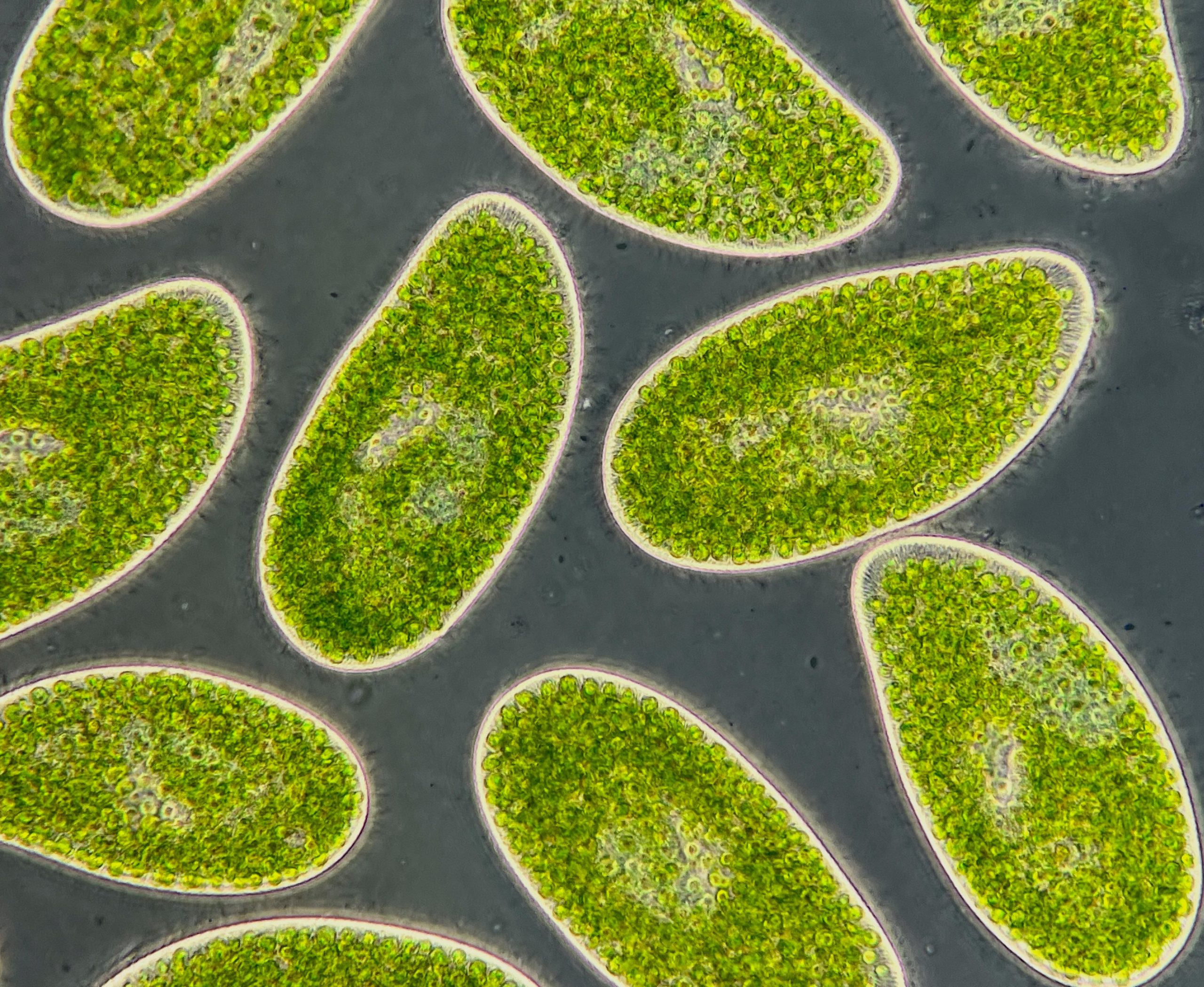
Dünyanın her yerindeki göllerde ve nehirlerde bulunan, bunun gibi tek hücreli canlılar Paramecium bursaria Hem yiyebilir hem de fotosentez yapabilir. Bunun gibi mikroplar, hayvan benzeri mi yoksa bitki benzeri bir yaşam tarzını mı benimsediklerine bağlı olarak, iklim değişikliğinde ikili bir rol oynarlar; ısınmanın birincil itici gücü olan ısıyı hapseden sera gazı olan karbondioksiti serbest bırakır veya emerler. Kredi bilgileri: Daniel J Wiczynski, Duke Üniversitesi
Artan ısı seviyeleri, okyanus planktonunu ve diğer tek hücreli organizmaları küresel ısınmayı şiddetlendirebilecek karbon eşiğine doğru itebilir. Bununla birlikte, son araştırmalar, bu organizmalar bu kritik noktaya ulaşmadan önce erken uyarı işaretlerini belirlemenin mümkün olabileceğini düşündürmektedir.
Yaygın ama genellikle gözden kaçan bir mikrop sınıfı üzerinde araştırma yapan bir grup bilim insanı, küresel ısınmayı yoğunlaştırabilecek bir iklim geri besleme döngüsü keşfetti. Ancak bu bulgunun olumlu bir yanı da var: Aynı zamanda bir erken uyarı sinyali de olabilir.
Bilgisayar simülasyonlarını kullanan Duke Üniversitesi ve Kaliforniya Üniversitesi, Santa Barbara’dan araştırmacılar, küresel okyanus planktonunun büyük çoğunluğunun yanı sıra göllerde, turbalıklarda ve diğer ekosistemlerde yaşayan birçok tek hücreli organizmanın devrilme noktasına ulaşıyor olabileceğini gösterdi. nokta. Burada karbondioksiti emmek yerine tam tersini yapmaya başlarlar. Bu değişiklik, metabolizmanızın ısınmaya tepki verme şeklinin bir sonucudur.
Karbondioksit bir sera gazı olduğundan, bu da sıcaklıkları yükseltebilir; bu, küçük miktarlardaki ısınmanın büyük bir etkiye sahip olduğu hızlı değişime yol açabilen pozitif bir geri besleme döngüsüdür.
Ancak araştırmacılar, Nature dergisinde 1 Haziran’da yayınlanan bir çalışmada, bolluklarını dikkatli bir şekilde izleyerek, devrilme noktasını buraya gelmeden önce tahmin edebileceğimizi bildiriyor. fonksiyonel ekoloji.
Yeni çalışmada araştırmacılar, iki metabolizma modunu karıştırdıkları için bu adı taşıyan miksotrof adı verilen bir mikroorganizma grubuna odaklandılar: Koşullara bağlı olarak bir bitki gibi fotosentez yapabilir veya bir hayvan gibi yiyecek avlayabilirler.
“Onlar … gibi[{” attribute=””>Venus fly traps of the microbial world,” said first author Daniel Wieczynski, a postdoctoral associate at Duke.
During photosynthesis, they soak up carbon dioxide, a heat-trapping greenhouse gas. And when they eat, they release carbon dioxide. These versatile organisms aren’t considered in most models of global warming, yet they play an important role in regulating climate, said senior author Jean P. Gibert of Duke.
Most of the plankton in the ocean — things like diatoms, dinoflagellates — are mixotrophs. They’re also common in lakes, peatlands, in damp soils, and beneath fallen leaves.
“If you were to go to the nearest pond or lake and scoop a cup of water and put it under a microscope, you’d likely find thousands or even millions of mixotrophic microbes swimming around,” Wieczynski said.
“Because mixotrophs can both capture and emit carbon dioxide, they’re like ‘switches’ that could either help reduce climate change or make it worse,” said co-author Holly Moeller, an assistant professor at the University of California, Santa Barbara.
To understand how these impacts might scale up, the researchers developed a mathematical model to predict how mixotrophs might shift between different modes of metabolism as the climate continues to warm.
The researchers ran their models using a 4-degree span of temperatures, from 19 to 23 degrees Celsius (66-73 degrees Fahrenheit). Global temperatures are likely to surge 1.5 degrees Celsius above pre-industrial levels within the next five years, and are on pace to breach 2 to 4 degrees before the end of this century.
The analysis showed that the warmer it gets, the more mixotrophs rely on eating food rather than making their own via photosynthesis. As they do, they shift the balance between carbon in and carbon out.
The models suggest that, eventually, we could see these microbes reach a tipping point — a threshold beyond which they suddenly flip from carbon sink to carbon source, having a net warming effect instead of a cooling one.
This tipping point is hard to undo. Once they cross that threshold, it would take significant cooling — more than one degree Celsius — to restore their cooling effects, the findings suggest.
But it’s not all bad news, the researchers said. Their results also suggest that it may be possible to spot these shifts in advance, if we watch out for changes in mixotroph abundance over time.
“Right before a tipping point, their abundances suddenly start to fluctuate wildly,” Wieczynski said. “If you went out in nature and you saw a sudden change from relatively steady abundances to rapid fluctuations, you would know it’s coming.”
Whether the early warning signal is detectable, however, may depend on another key factor revealed by the study: nutrient pollution.
Discharges from wastewater treatment facilities and runoff from farms and lawns laced with chemical fertilizers and animal waste can send nutrients like nitrate and phosphate into lakes and streams and coastal waters.
When Wieczynski and his colleagues included higher amounts of such nutrients in their models, they found that the range of temperatures over which the telltale fluctuations occur starts to shrink until eventually the signal disappears and the tipping point arrives with no apparent warning.
The predictions of the model still need to be verified with real-world observations, but they “highlight the value of investing in early detection,” Moeller said.
“Tipping points can be short-lived, and thus hard to catch,” Gibert said. “This paper provides us with a search image, something to look out for, and makes those tipping points — as fleeting as they may be — more likely to be found.”
Reference: “Mixotrophic microbes create carbon tipping points under warming” by Daniel J. Wieczynski, Holly V. Moeller and Jean P. Gibert, 31 May 2023, Functional Ecology.
DOI: 10.1111/1365-2435.14350
The study was funded by the Simons Foundation, the National Science Foundation, and the U.S. Department of Energy.

“Analist. Tutkulu zombi gurusu. Twitter uygulayıcısı. İnternet fanatiği. Dost pastırma hayranı.”





More Stories
‘Beni ürpertti’: Bilim adamları, şimdiye kadar gözlemlenen en güçlü gama ışını patlamasının bir sır sakladığını söylüyor
NASA’nın Perseverance gezgini, Mars’ta eski yaşama işaret edebilecek bir kaya buldu
Neandertal gibi yemek pişirmek ister misin? Arkeologlar sırları keşfediyor